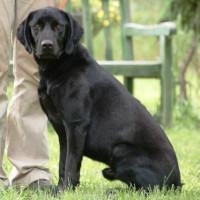Appearance of the German Shorthaired Lab
|
| German Shorthaired Labs have a pleasing appearance, with good musculature and a truly athletic conformation. Their skull is large and broad, with a strong muzzle that tends not to be as long as that of the Braque. Their ears are generally large and broad, often extending beyond the jaw. They are robust yet elegant, carrying themselves with quiet dignity. Their limbs are long and strongly built, yet allow for a rapid pace. They generally have a broad tail, particularly thick at the base. Although there is some variation, most German Shorthaired Labs will weigh between 25 and 30 kg and measure between 53 and 60 cm. The German Shorthaired Lab's short coat may well be black, chocolate and yellow in Labrador, but will often feature white spots and markings. |
Temperament of the German Shorthaired Lab
|
| Both adventurous and jubilant, the German Shorthaired Lab is a real pleasure, and it's hard to stay in a bad mood for too long in their company. They approach any task given to them with joy and enthusiasm, and are never afraid of a new challenge. They have a seemingly endless supply of energy, and require a great deal of mental and physical stimulation to keep them satisfied. When it comes to sociability, the German Shorthaired Lab is an undeniable social butterfly. Friendly and outgoing, these dogs love being in human society, particularly enjoying the opportunity to play with young children and have fun. Despite this, parents must take care to supervise youngsters in their company to avoid them being knocked over by an overexcited dog. These dogs truly live to please their owners and will always try to be cooperative and well-behaved. Rarely hostile, the German Shorthaired Lab is a mediocre watchdog, although a number of dogs of this breed may initially be wary and calm around new people. Full socialization when you're young can help you quickly overcome any shyness. |
Needs and activities of the German Shorthaired Lab
|
| The German Shorthaired Lab is a very active dog. He'll need exercise to keep the weight off. What's more, exercise can be used to work both his body and his brain. He'll enjoy agility, obedience training and visits to the dog park where he can hone his social skills. This hybrid needs a home with a fenced yard, so he's not suited to apartment living. Barking, chewing and other malicious behaviors can occur if he doesn't get enough fresh air, physical activity and mental stimulation. He could be an excellent jogging or hiking partner if the opportunity arose. |
Maintenance of the German Shorthaired Lab
|
| The German Shorthaired Lab is generally double-layered. The top coat is short, thick and straight, and can be longer on the underside of the tail and hips. The undercoat is soft but protective, and repels water, enabling him to swim in cold water. He doesn't shed much, and doesn't need much extra grooming. Brush on every day. In times of heavy shedding, you can use a dead-hair removal tool to help eliminate loose fur. It can be washed once every two months, unless of course it's dirty or muddy. Because this hybrid loves water so much, it can be prone to ear infections. Make sure his ears are completely dry after each bath. An active dog like this may wear down his nails naturally, but check them regularly in case they need trimming. Brush his teeth every two or three days. |









 English (United Kingdom)
English (United Kingdom)